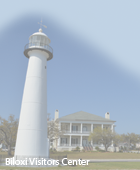By Edmond Boudreaux Jr.
Local Historian
During the course of Biloxi’s history, eight flags have flown over her and the Mississippi Gulf Coast. These flags included the flags of six countries: France, England, Spain, the Republic of West Florida, Confederate States of America, and the United States stars and stripes. The other two flags were state flags: the Magnolia State Flag and the current Mississippi State flag. With this in mind let us look at Biloxi’s history.
Biloxi was inhabited by Native Americans as early as 8,000 BC up to the 1700s. Artifacts from the four major periods of Native American history have been found on Biloxi’s peninsula.
In 1697, the Comte de Pontchartrain, French Minister of Marine, gave Pierre Le Moyne, Sieur d’Iberville orders to locate the mouth of the Mississippi River. On September 5, 1698 Iberville’s expedition left La Rochelle, France. Iberville arrived at Ship Island on February 10, 1699. On February 13, Iberville and 14 men landed on the mainland at present-day Biloxi. After several days the French became friends with the Biloxi Indians. The Biloxi’s spoke the Sioux language and most likely migrated from the Northeast. There is some indication that they arrived along the Mississippi Coast a short time before the French.
In 1719 numerous concessions lined the shores of Biloxi. The capital was transferred to Biloxi in 1720 and remained there until 1723 when it was moved to New Orleans. In 1763 the French ceded its territory east of the Mississippi to England. In 1770 Lieutenant Thomas Hutchins indicated that inhabitants at Biloxi were the offspring of the original settlers. In 1779 the Mississippi Coast was ceded to Spain.
In 1810 Biloxi became part of the short-lived Republic of West Florida. In 1811 Dr. William Flood, acting as ambassador for Governor Claiborne of Louisiana, investigated the Mississippi Coast for the United States. He indicated the population of Biloxi to be 420 people.
In 1817 Mississippi became a State. Between 1817 and 1860 Biloxi began the slow development into a favorite summer resort place for many southerners. In 1838 Biloxi was incorporated as a township and in 1848 the Biloxi Lighthouse was erected and would become the symbol of Biloxi.
By late 1850s Biloxi had several fine hotels. They included the Magnolia Hotel, American Hotel, Biloxi House, Green Oaks Hotel, and Shady Oaks Hotel.
In 1861 Mississippi ceded from the United States and the Civil War had begun. Biloxi Rifles were part of the 3rd Mississippi Infantry CSA, which was made up of Mississippi Gulf Coast Natives. On December 31, 1861 Biloxi surrendered to Union Naval Forces who were operating from Ship Island.
The period immediately after the Civil War was a difficult time for Biloxi. In 1872 the L&N Railroad established the Seashore Camp Ground in Biloxi as a flag stop. In 1881 Lopez, Elmer and Company became the first seafood cannery in Biloxi and by the end of the decade four additional canneries were established. In 1888 the schooner races of the White Wing Queens began and lasted until 1933.
By the turn of the century Biloxi had become the Seafood Capital of the World. In the 1920s there were more than 40 seafood factories occupying the two cannery districts.
Some of the first fishermen were Austrians from the Dalmatia Coast. In 1890 the Bohemians became the first imported laborers from Baltimore. In 1914 the first Cajun families arrived from Louisiana.
In 1908 the first Mardi Gras Parade took place in Biloxi with John Carraway as King and Miss Blanche Picard as Queen. In 1927 Biloxi hotels included the Edgewater Gulf Hotel, White House Hotel, Tivoli Hotel, Buena Vista Biloxi Hotel, Kennedy Hotel, Park Hotel, Avelez Hotel, and Rivera Hotel. Also, in 1927 the seawall was constructed to protect the Mississippi Gulf Coast. In 1929 the first Blessing of the Shrimp Fleet took place in Biloxi.
Between 1934 and 1947 a Coast Guard Air Station was located on Biloxi’s Point Cadet. In 1941, Biloxi was the site for an Army Air Corp technical training base known as Keesler Field. Today Keesler Air Force Base is the location for many technical schools and employs many local people.
Hurricanes have devastated the Mississippi Coast for years. Some most notable were the 1722, 1893, 1915, and 1947 hurricanes. But on August 17, 1969 Hurricane Camille dealt Biloxi a catastrophic blow. Like in the past Biloxians immediately started rebuilding.
After Hurricane Camille, the economy of Biloxi recovered, but slowly. All that changed in 1992 however, when the State of Mississippi chose to allow legalized dockside gaming. The success of gaming in Biloxi has had a wondrous effect on all elements of the city. Biloxi appeared to be on a fast growth path with nothing to slow it down. Then on August 29, 2005 Katrina brought all of that to a stand still.
Hurricane Camille proved the people Biloxi could come back and rebuild. The same can be said for the survivors of Katrina. Biloxi is now the site of new developments and recovery. Like past catastrophic storms Biloxi immediately began the process of rebuilding while at the same time building a new future.































